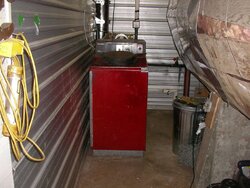so I have been looking for options other than the usual (buying or building a non-pressurized tank with lotsa copper in it) used/refurbished LP tanks, or something else. what I've come across is steel fuel/other liquid tanks like these:
http://www.turnertanks.com/Horizontal.html
stood on end, these would be awesome and cheap buffer tanks. We have to install as non-pressurized here, so I plan on doing a euro-closed system with expansion vessel connected to air scoop/top of tank.
can anyone come up with a reason not to do this? we can certainly treat the water if needed, but the internals of the boilers are bare steel if I recall correctly. some o2 scavenging chemicals are certainly cheap if they're needed.
we could certainly use a double wall tank if it's wise.
cheers,
karl
http://www.turnertanks.com/Horizontal.html
stood on end, these would be awesome and cheap buffer tanks. We have to install as non-pressurized here, so I plan on doing a euro-closed system with expansion vessel connected to air scoop/top of tank.
can anyone come up with a reason not to do this? we can certainly treat the water if needed, but the internals of the boilers are bare steel if I recall correctly. some o2 scavenging chemicals are certainly cheap if they're needed.
we could certainly use a double wall tank if it's wise.
cheers,
karl


